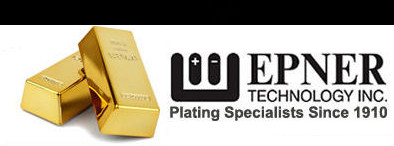
It was 1982 when President Ronald Reagan asked Lee Iacocca to raise the money and manage the total restoration of the crumbling Statue of Liberty in New York Harbor. The center piece of the restoration was to restore the torch flame which had not “burned” for decades.
Mr. Iacocca contacted our 75 year-old plating firm, Epner Technology, to plate the new flame with a thick layer of pure 24Kt. gold. The old flame, presently on display at the recently opened Statue of Liberty Museum, was made of glass sections and lighted from the inside. It’s replacement was to be fabricated from individual panels of copper hammered into a female die to create individual shapes that, when fitted together, would form the new flame.
At night a ring of lights around the base of the flame, would set the gold surface “afire.”
Each panel was approximately four feet by four feet or 16 ft.² of surface area on one side. Mr. Iacocca was relying on Epner Technology’s decades of experience to come up with a specification that would last, “one-hundred years in New York Harbor.”
Because the panels were so large, it was apparent that we would have to
purchase and install a dedicated facility of some fifteen tanks with pumps,
filters, power supplies, etc to be able to plate the 20 or so individual panels
that would be assembled for the flame. The gold-plating tank alone would
contain more than a half-million dollars of gold solution.
But there was a much more serious issue than just the ability to copper, nickel
and gold plate these large metal sections. A phenomenon known as galvanic corrosion would cause the gold
plating to self destruct.
When a noble metal such as gold is in contact with a base metal such as copper or nickel, in the presence of an electrolyte such as the moist salt atmosphere of New York Harbor, it will cause the less noble metal to sacrifice itself electro-chemically and in a very short time the gold plating would be peeling off. This self destruction would be accelerated by the fact that the hammering, required to shape each piece, would create an extremely porous and stressed surface making it almost impossible for the plating to seal these defects. All it would take is one pin-hole to begin corrosion process.
And so, we found ourselves faced with an interesting moral dilemma. Do I take
the million dollars budgeted for the plating of this project and hope for the
best, or do I tell Mr. Iacocca what I knew in my heart was the proper way to
get a durable gold on the Statue of Liberty flame?
It was not by electroplating, but rather, the ancient technology of gold-leaf. Because the incredibly thin pieces of gold are not applied against a metal surface but, over varnish, a non conductive inert material, so there is no metal-to-metal galvanic couple, thus no corrosion.
Gold-Leaf has been used on the domes of buildings and churches for hundreds of years because even salt air has no effect on pure gold.
Mr. Iacocca was grateful for the advice and the education in electro-chemistry. Fittingly, a French company was chosen to supply the gold-leaf to the new flame which has been glowing each night for more than thirty year.
